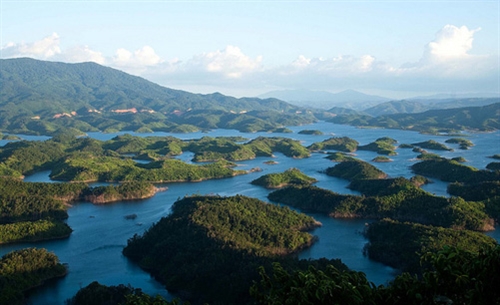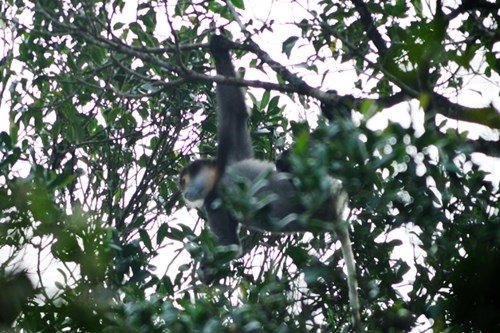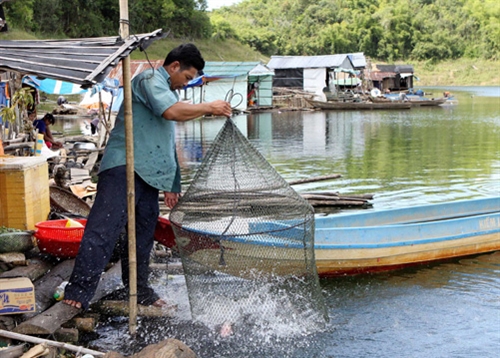 Life & Style
Life & Style

With countless tracts of magnificent untouched rainforest showing the region’s age-old natural and cultural legends, Tây Nguyên (Central Highlands) is still a mysterious land to most tourists.
 |
| Miniature ’Hạ Long Bay’: Tà Đùng nature reserve seen from above. — Photo credit: baotintuc.vn |
By Mộc Miên
With countless tracts of magnificent untouched rainforest showing the region’s age-old natural and cultural legends, Tây Nguyên (Central Highlands) is still a mysterious land to most tourists.
We had a chance to visit the nature reserve Tà Đùng, one of the most photogenic forests in the region, where many rare and nearly extinct animals on the Red List of Threatened Species live.
It is also a wonderful trekking experience to conquer the 2,000m peak of Tà Đùng mountain, which is truly one of a kind.
As the dry season started, the yellow marigolds were in full bloom, brightening Ho Chi Minh Highway as it passed through Tây Nguyên. From Buôn Ma Thuột, we drove 200km through many tortuous mountain passes from dawn until dusk. Finally, we reached the Tà Đùng Nature Reserve Office, located in Đắk Som Commune, Đắk G’long Village, Đắk Nông Province.
From a distance, Tà Đùng peak is concealed by floating clouds.
Tà Đùng is the highest peak in Đak Nông province. On top of Tà Đùng, one sees a bird’s eye view of the vast Đắk Nông area.
The Châu Mạ people live only 1km away from Road 28.
Crystal clear streams flow through the foothills surrounding Tà Đùng. During the dry season, the water is quite shallow, yet clear and refreshing. This attracts youth from the surrounding area. People from as far away as Di Linh, Gia Nghĩaa town sometimes drive here for the weekend.
The forest welcomed us with a feathered orchestra of red-whiskered bulbul, nightingale, wild goose, and other birds. The sound of the powerful Dinh Klinh waterfall also greeted us.
Khương Thành Long, deputy director of Tà Đùng Nature Reserve, enthused: “This phenomenal diversity of bird species is endemic in this forest. Tà Đùng is one of the few bird reserves in Việt Nam, and one of the world’s most important bird reserves.”
Passing Dinh Klinh waterfall, we reached the rainforest, with its multistoried foliage. A few rays of sunlight slithered through the dense greenery. Old trees had their roots protruding nearly 20cm from the ground. Peculiar-shaped trees, each spread their branches over a few dozen square metres. Some trees looked as if they climb around and strangle other trees. Other trees featured python skin-patterned bark.
Our local tour guide warned: "We are entering the old rainforest. There are a lot of animals, insects, steep and rocky slopes, deep abysses, and tangled bushes. You all should be really careful.”
My whole group chitchatted as we hiked. Then the sound of something moving through the branches above our heads caught our attention. The sound drew increasingly closer. It was a group of redshank doucs swinging through the branches. Everyone was so excited and whipped their cameras out. But the doucs swiftly hide themselves behind the greenery.
“I was so excited to actually see this endangered primate. Such a rare chance in my life,” Jay Smith, a group member, remembered.
As we continued hiking, our conversation ranged beyond black-shanked doucs to other species of animals that are near extinction, as well as to gibbon, bear, loris, Cypress family, golden camellia, and more.
As we walked deeper into the woods, the scenery grew more interesting. But the terrain became more challenging. Steep slopes forced everyone to bend their bodies and grab tightly to small bushes along the way to move forward. We took breaks to catch our breaths again, looking at each other, tired yet still excited.
“Nature in Tây Nguyên is said to be extremely rough. Now, I’ve had a chance to witness it with my own eyes and experience Nature’s challenge. What a truly unique experience.” said veteran traveller Trần Huy Hoàng.
By the second day of the trip, our feet adapted to meet the demands of hiking. We left our baggage in our hut. So we didn’t have to carry any additional weight. We all felt excited to summit a peak that many travellers dream of. Although there weren’t any trails, the path was easy to pass through. Footprints of the chamois -- one of few species that can survive the cold climate on the mountain -- were imprinted on a layer of moss. The higher we climbed, the less trees grew; there were a few bushes and some moss.
Less than 2 hours later, we set foot on the peak of Tà Đùng mountain, bursting with happiness and fulfilment. We felt like we were floating among the clouds. We closed our eyes, breathed the fresh air, then took in a bird’s eye view of the Đắk Nông’s urban area, barely visible through layers of fog.
Without resting, everyone started taking photos to capture these special moments. Then we prepared to trek downhill before dusk.
Walking downhill was as hard as going uphill. We had to bend our knees and lower our bodies to keep our balance. Leaving the woods, we could feel our legs trembling and our calves aching after the long hike.
We drove by the coffee grove to catch a glimpse of the fully ripe coffee berries.
In the honey-colored sunlight of late autumn, Tà Đùng lake looked like a miniature of Hạ Long Bay from high above. The clear blue water contrasted with the wild forest of the Central Highlands and surrounded many isles. The few boats of the local fishermen looked like the fins of hunting sharks.
“From a distance, nature is beautiful and calm. Who knew that life inside the forest would be so lively and fascinating? This is the first time I’ve been to Tây Nguyên. Perhaps I was enchanted during the two day hiking trip,” said Nguyễn Diệu Hà, a member of the hiking party.
 |
| Camera shy: A rare picture of the black-shanked douc in Tà Đùng forest.— Photo Credit: baotintuc.vn |
 |
| Water world: Farming seafood on Tà Đùng lake. — Photo Credit: baotintuc.vn |